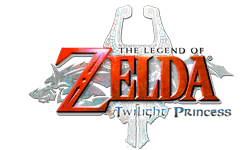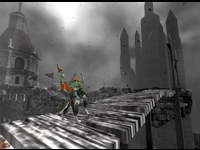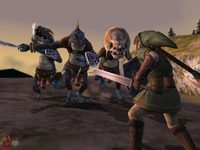|
|

|
BATTLE SYSTEM
|

|
INTERACTION
|

|
ORIGINALITY
|

|
STORY
|

|
MUSIC & SOUND
|

|
VISUALS
|

|
CHALLENGE
|
Medium
|
COMPLETION TIME
|
35-45 hours
|
|
OVERALL
3.5/5
|
Rating definitions
|
|
|
The Legend of Zelda: Ocarina of Time, more often referred to as OoT, is by far one of the most prominent RPGs ever released. In fact, many claim that it is both the best RPG and best game ever made. So, of course, both gamers and critics would look to Nintendo to see if they could do it again. The sequels that followed were excellent but still couldn't compare to the masterpiece that is OoT. But when Miyamoto claimed that Legend of Zelda: Twilight Princess would be the best Zelda game to date, it turned quite a few heads and expectations rose high. So, the question is, is it truly better than OoT? The answer is, sadly, no. Instead, it relies heavily on the conventions set by OoT when it could have been something truly special and revolutionary. Still, it's a great game, but hints of it being a launch title are quite evident.
The story begins similar to most Zelda titles. Link starts the adventure as a rancher boy in Ordon Village. After a performing a few chores, he is given the task of journeying to Hyrule Castle to offer a gift from the village. But after awhile, things go awry, and Link finds himself trapped in an unknown dimension. To make things worse, he has been turned into a wolf. As he attempts to escape he encounters a female creature named Midna, who decides to help him on his quest, with her own ends in mind. Link soon discovers that Hyrule has been covered in darkness by a mysterious being and it is up to him to save the land from being completely devoured by it.
The pacing is much slower than the usual Zelda title. It'll be a long time before Link even gets a real sword, and even longer before he gets his famous green tunic. Important events happen little by little, enticing the player to continue pressing forward. Regrettably, there are no huge plot twists like there were in OoT and Wind Waker . Everything is pretty straight-forward all the way to the obvious final boss. Though the story is simple, it's refreshing to have so many new characters play a part in Link's journey. Link's interactions with these new characters are what makes the story so great this time around. Without them, it just would feel empty and lack any sort of motivation.
 The interactions between Midna and Link are what drives the story.
The interactions between Midna and Link are what drives the story.
|
|
Plot aside, the dungeon design the real highlight of the game. Each dungeon, especially the latter ones, is ingeniously conceived. Players will definitely have to use their heads to solve these amazing puzzles. Just about every item Link finds must be used in some intriguing fashion. Puzzles range from simple, but still enjoyable, to quite complex. But as great as the dungeons are, some of the last ones might become annoying sessions of trial-and-error. In these, the solution of the puzzles becomes a question of what Link can actually do with his items and weapons. The solution might seem clear in the end, but players might take a good while to figure it out simply because they didn't realize all the capabilities of a certain weapon. To list examples here would spoil the experience, so players will just have to go through those frustrations alone. Thankfully, there are only a few occasions of this minute issue. Another complaint is that some of the earlier dungeons are just far too similar in design and appearance to those in OoT. They even occur in the exact same order as they did in the game. It feels like playing OoT all over again, which might not be a bad thing, but it can be for players looking for something new. But even that won't keep them from enjoying the huge labyrinths, figuring out solutions to each challenge, and feeling smart in the process.
The big question of every Zelda fan's mind, the one that will most likely decide if one will buy the Gamecube version or the Wii version, is whether the Wii controls are as great as Nintendo promised. It might vary from person to person, but most likely, the answer to that question is no. Using the Wii remote to swing Link's sword just isn't as fluid nor precise as pressing a corresponding button. First off, Link's sword swing doesn't actually match the swing of the Wii remote. As a consequence, the controls end up feeling tacked-on. This cosmetic inequity is only annoying for most of the adventure, but in the few instances that require precision, it becomes frustrating. For instance, Link learns two moves that require the use of the Nunchuk. With one, the player must shake it from side to side to perform Link's famous spin attack. For the second, the player must thrust the Nunchuk forward for Link's shield attack. Players will often find Link using the spin attack when they intended him to use the shield attack. This is just one example of the frequent imprecisions. Another is when a player exploits a boss's weakness and is able to strike it with Link's sword. Clean sword strikes are nigh impossible with the Wii remote. So, naturally, the player might end up wildly flailing the remote to get as many strikes in as possible before the boss recovers. Speaking of bosses, all of them, even the predictable final boss, are all very easy. Most feature glaringly evident weaknesses and easily recognizable patterns. Though the battles are quick and easy, their saving grace is that they are still good fun and quite cinematic in presentation. Overall, gameplay suffers due to imprecise controls.
 This is where you swing the Wii-mote like you've never played a video game in your life.
This is where you swing the Wii-mote like you've never played a video game in your life.
|
|
It's sad to say, but the graphics of Twilight Princess calls attention to the fact that this version was indeed rushed. The game exhibits the exact same graphical quality of the Gamecube version. No sort of enhancements will be found here. Most of the game's visuals appear muddy and dated, especially with backgrounds and floors. This is mostly apparent in the overworld of Hyrule; everywhere else, it's not that bad. But still, this is the next generation of gaming, and graphics should reflect a system's abilities. It would have been great if Nintendo took some time tweaking the graphics using the Wii's superior power. Most gamers won't might, but it's still a shame that they missed such a good opportunity to show off just what the Wii can do. The game does have a beautiful art style though. Link and the rest of the gang have definitely come a long way from the chubby chibi style art of the old Nintendo titles. Now, the characters are so richly detailed. Take Link for example. His tunic is nicely fashioned, with several layers of different materials, including cloth and metal, and his gauntlets and boots are evidently made of a fine leather. That's just one example of how the world is meticulously designed. Still, it's hard not to wonder how great the game would have looked with just a bit of polish.
The sound is on par with the graphics. The game's sound design can be summed up with one phrase, "The age of MIDI is over." Like any Zelda title, Twilight Princess features some nice tunes, but they are greatly impaired due to the MIDI quality. Put simply, the songs should have been orchestrated. Such a high-caliber franchise as Zelda should have high-calibur sound. That's all there is to it. The sound issue is made worse by the utter lack of voice acting. Link never speaks, which is expected, but there's just no excuse why no one in the game has a proper voice. There are a few sound bits for laughs, grunts and such for most characters, but that just doesn't cut it. The sheer lack of voices makes the game feel lifeless when compared with other next generation games. Voice acting would have greatly added to each character's personality, something mere text dialogue can't do. As it is, the translation's still great, and the characterization still permeates through the text, but if only... Also, the game utilizes the Wii-mote's internal speaker for various sounds, like bomb explosions and sword swings. However, these feature is unimpressive at best. The quality of the speaker makes everything sound tinny and cheap instead of realistic. It was a good idea in theory, but it doesn't work here. Hopefully, Nintendo will improve it or choose not to use it in future iterations. Ultimately, the sound is disappointing due to the omission of voice acting and lack of quality that has become a standard in this generation of gaming.
Legend of Zelda: Twilight Princess is a good game. Nonetheless, it feels like playing OoT all over again instead of a true sequel. Majora's Mask and Wind Waker are much better titles because they bring something unique to the Zelda formula. In Majora's Mask, the player had to race against time and could use various masks to transform into different races. Wind Waker featured impressive cel-shaded graphics and introduced the element of sailing. But the only thing different here would be the wolf mechanics, which aren't all that great. Still, Zelda fans will love this game simply because it's a classic Zelda title, through and through. Gamers looking for something different from the usual might get bored before the end of this 35 hour quest. However, if the player doesn't mind playing a similar title, then he or she can expect to enjoy a decent story, amazing and intricate dungeons, and tons to collect and explore, but might have to suffer with loose controls and low technological quality in order to do so.
Review Archives
|









